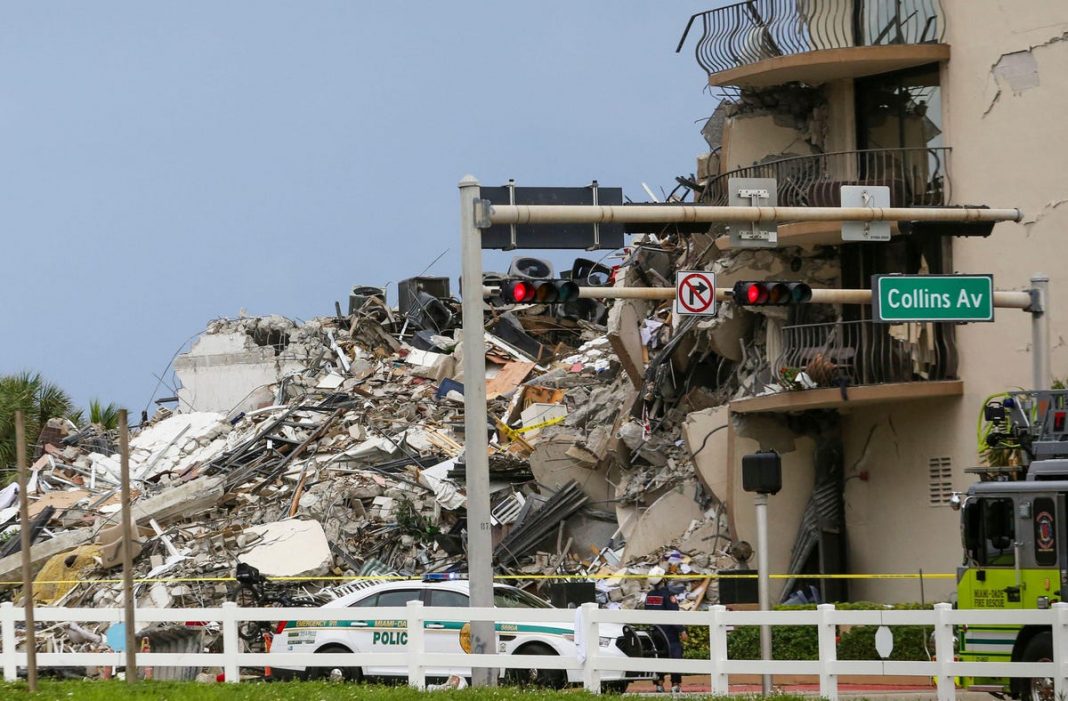Debris from a partially collapsed Champlain Towners condo building in Surfside north of Miami Beach, … [+]
AFP via Getty Images
We are conditioned to think about a 30-year mortgage as a great deal, and when experts suggest we budget for maintenance costs, we tend to think about things like a new dishwasher or refrigerator, or maybe a bathroom or kitchen renovation. We don’t normally think about shoring up the concrete or the foundation, until and unless a contractor or inspector finds something amiss during the renovation – or a crisis.
Buildings are big and made of concrete and steel and go through all kinds of inspections by people who know these things better than we do, including structural engineers and architects. So, we feel safe in them.
Then a catastrophe like the building collapse in Surfside, Florida that killed 97 people hits and shakes us to our core.
Though we don’t know if climate played a role, we have seen photos that indicate corrosion from the humidity and water seepage, and Miami-Dade County, where Surfside is located, is at grave risk from sea-level rise.
Experts have been talking about the potential impact of climate change on buildings for decades (which is how we have the US Green Building Council and their LEED certification), yet, even as we experience those impacts every day in 2021 – with many more extreme weather events, much higher temperatures and many more droughts and wildfires – upgrades to our buildings, ordinances and infrastructure are painfully, dangerously slow.
Why are these obvious risks being ignored?
danger sign, pixabay.com
Pixabay.com
“When it comes to Surfside, building retrofits, and climate change, the most important bias affecting risk perception, in my mind, is solution aversion,” Michele Wucker, author of the new best-selling book, “You Are What You Risk: The New Art & Science of Navigating An Uncertain World,” wrote me.
“That is, if you don’t like the solution, you minimize the risk. The Surfside condo board had sticker stock when it came to what had to be done which is why they delayed for three years. Because they did not like the solution, they dialed down their risk perceptions involving the building safety issues,” she added.
Another factor social psychologist and “risk scholar” Paul Slovic identified that seems at play in Surfside, according to Wucker, is “immediacy” bias, which means, “we perceive threats as less urgent when we think they lie far in the future.” Implementing climate change mitigation strategies falls into this category too (as do financial planning or lifestyle changes), because, despite the overt evidence climate change is here today, many people still think of it as a future risk.
Whose job is it?
So, whose job is it to make us think about the dangers of threats we perceive as “far in the future,” such as retrofitting to mitigate structural risks from climate factors, and/or the need for large-scale maintenance costs like Surfside urgently needed? Even though these will be expensive and disruptive, if they are not done, they could put lives at risk, especially in multi-family dwellings like condominium buildings where hundreds of lives are at risk.
Kate Simonen, University of Washington and Executive Director of the Carbon Leadership Forum
Kate Simonen
“I think if we recognize that, since there’s a public safety issue that goes in direct competition to the financial interest of building owners, it falls right in the role of civic government,” structural engineer and architect, Professor and Chair of Architecture at the University of Washington Kate Simonen explained in an extensive interview. She’s also Executive Director of the Carbon Leadership Forum.
Minneapolis, MN Code of Ordinances
https://www.minneapolismn.gov/government/charter-and-code-of-ordinances/
To address the potentially dangerous challenge, Simonen suggested that a city ordinance “would put more teeth, which would then give the requirements and maybe some timeframe to acting so that it would mandate.” That means, Simonen added, “Rather than waiting for everybody to vote, they would just actually have to act. ‘In order for our building not to get condemned, we have to do this work by this date,’ ” even if the increased cost causes some of the condo owners financial distress or even to sell their condos.
City ordinances like this could be put in place to address climate change mitigation, as well as structural deficiencies identified in inspections like happened in 2018 with Surfside, Simonen said, as the nonprofit Architecture 2030 is nudging the built environment to do with its “2030 Challenge.”
Who will act?
(Photo by Fairfax Media via Getty Images via Getty Images)
Fairfax Media via Getty Images
Will the dramatic and sudden collapse of Surfside’s Champlain Towers be the wake-up call that makes condo boards, building management teams and elected officials who need to revamp city ordinances move with greater urgency to address the impact of a rapidly changing climate on the safety of their local buildings?
Let’s hope they see the dangers of their own “solutions-aversion,” find creative financing to address the sticker-shock, and act. Before another avoidable danger hits.
Watch for my full interview with Michele Wucker on her book about risk on my podcast Green Connections Radio coming soon too.




